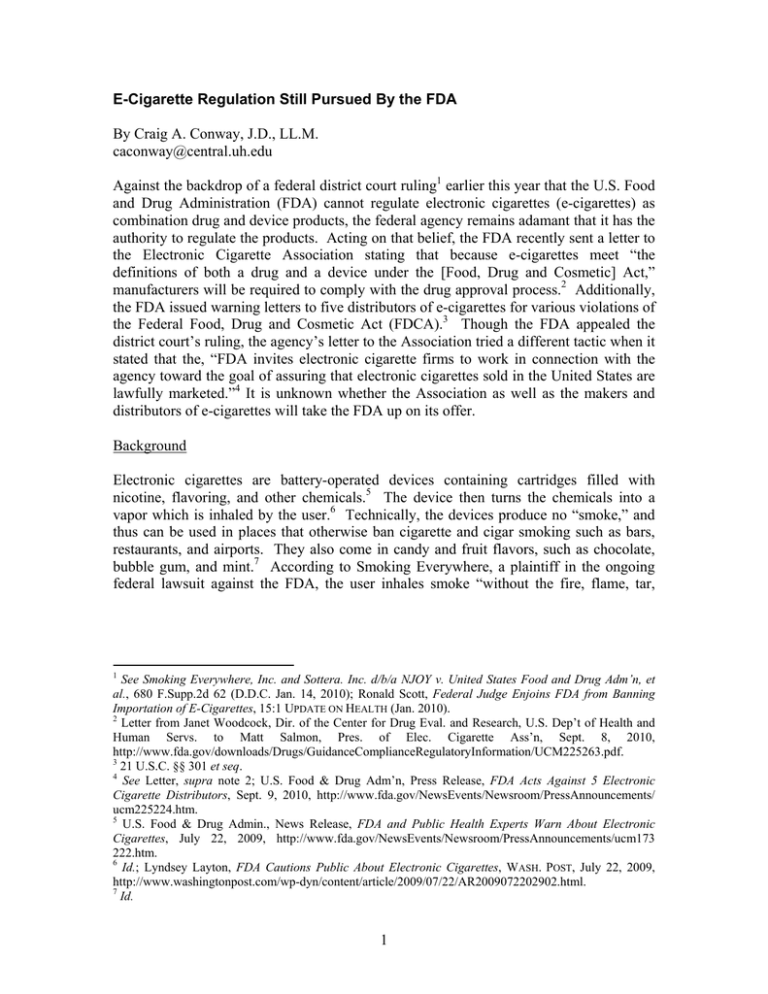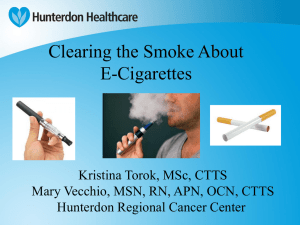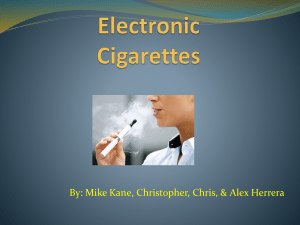By Craig A. Conway, J.D., LL.M.
advertisement

E-Cigarette Regulation Still Pursued By the FDA By Craig A. Conway, J.D., LL.M. caconway@central.uh.edu Against the backdrop of a federal district court ruling1 earlier this year that the U.S. Food and Drug Administration (FDA) cannot regulate electronic cigarettes (e-cigarettes) as combination drug and device products, the federal agency remains adamant that it has the authority to regulate the products. Acting on that belief, the FDA recently sent a letter to the Electronic Cigarette Association stating that because e-cigarettes meet “the definitions of both a drug and a device under the [Food, Drug and Cosmetic] Act,” manufacturers will be required to comply with the drug approval process.2 Additionally, the FDA issued warning letters to five distributors of e-cigarettes for various violations of the Federal Food, Drug and Cosmetic Act (FDCA).3 Though the FDA appealed the district court’s ruling, the agency’s letter to the Association tried a different tactic when it stated that the, “FDA invites electronic cigarette firms to work in connection with the agency toward the goal of assuring that electronic cigarettes sold in the United States are lawfully marketed.”4 It is unknown whether the Association as well as the makers and distributors of e-cigarettes will take the FDA up on its offer. Background Electronic cigarettes are battery-operated devices containing cartridges filled with nicotine, flavoring, and other chemicals.5 The device then turns the chemicals into a vapor which is inhaled by the user.6 Technically, the devices produce no “smoke,” and thus can be used in places that otherwise ban cigarette and cigar smoking such as bars, restaurants, and airports. They also come in candy and fruit flavors, such as chocolate, bubble gum, and mint.7 According to Smoking Everywhere, a plaintiff in the ongoing federal lawsuit against the FDA, the user inhales smoke “without the fire, flame, tar, 1 See Smoking Everywhere, Inc. and Sottera. Inc. d/b/a NJOY v. United States Food and Drug Adm’n, et al., 680 F.Supp.2d 62 (D.D.C. Jan. 14, 2010); Ronald Scott, Federal Judge Enjoins FDA from Banning Importation of E-Cigarettes, 15:1 UPDATE ON HEALTH (Jan. 2010). 2 Letter from Janet Woodcock, Dir. of the Center for Drug Eval. and Research, U.S. Dep’t of Health and Human Servs. to Matt Salmon, Pres. of Elec. Cigarette Ass’n, Sept. 8, 2010, http://www.fda.gov/downloads/Drugs/GuidanceComplianceRegulatoryInformation/UCM225263.pdf. 3 21 U.S.C. §§ 301 et seq. 4 See Letter, supra note 2; U.S. Food & Drug Adm’n, Press Release, FDA Acts Against 5 Electronic Cigarette Distributors, Sept. 9, 2010, http://www.fda.gov/NewsEvents/Newsroom/PressAnnouncements/ ucm225224.htm. 5 U.S. Food & Drug Admin., News Release, FDA and Public Health Experts Warn About Electronic Cigarettes, July 22, 2009, http://www.fda.gov/NewsEvents/Newsroom/PressAnnouncements/ucm173 222.htm. 6 Id.; Lyndsey Layton, FDA Cautions Public About Electronic Cigarettes, WASH. POST, July 22, 2009, http://www.washingtonpost.com/wp-dyn/content/article/2009/07/22/AR2009072202902.html. 7 Id. 1 carbon monoxide, known cancerous substances, ash, stub, or smell found in traditional cigarettes.”8 Selling from between $50 to $200, the e-cigarette looks similar to a normal cigarette or cigar, but longer. They essentially all work the same way: a user inhales through a mouthpiece; air flow triggers a sensor that switches on a small, battery-powered heater; the heater vaporizes liquid nicotine in a small cartridge and activates a light at the “lit” end of the device (users may opt for a non-nicotine cartridge); the heater also vaporizes propylene glycol (PEG) in the cartridge – the same compound used in theatrical smoke; the user gets a puff of hot gas that feels a lot like tobacco smoke; and then when the user exhales, there is a cloud of PEG vapor that looks like smoke and then dissipates.9 Last year, the FDA’s Division of Pharmaceutical Analysis tested and analyzed 19 varieties of cartridges which hold the liquid, and two e-cigarettes, one marketed by Florida-based Smoking Everywhere, Inc., and one by NJOY, of Scottsdale, Arizona.10 Investigators found the majority of the items tested contained tobacco impurities believed to be harmful.11 Additionally, some products tested positive for nicotine even though the product’s label touted there was no nicotine present. Several of the cartridges contained detectable levels of nitrosamines, a tobacco-specific compound linked to cancer.12 One Smoking Everywhere cartridge was found to contain diethlyene glycol, a common ingredient found in antifreeze.13 In response to the FDA’s findings last year, the Electronic Cigarette Association (ECA), issued a statement that said: …the FDA’s laboratory analysis of electronic cigarettes released today is too narrow to reach any valid and reliable conclusions and ignores the continued efforts by its member companies to ensure that their products include health warnings and to only market its products as an alternative to long-time, adult smokers.14 8 Smoking Everywhere, Inc. and Sottera. Inc. d/b/a NJOY, 680 F.Supp.2d at 63; Ronald Scott, Federal Judge Enjoins FDA from Banning Importation of E-Cigarettes, 15:1 UPDATE ON HEALTH, Jan. 2010, p. 1. 9 Daniel J. DeNoon, FDA: E-Cigarettes Bad, But Not Banned, WEBMD HEALTH NEWS, July 22, 2009, http://www.webmd.com/smoking-cessation/news/20090722/fda-ecigarettes-bad-not-banned. 10 Steven Reinberg, E-Cigarettes Pose a Health Hazard, FDA Warns, HEALTHDAY, July 22, 2009, http://healthday.com/printer.asp?AID=629298; Shirley S. Wang, FDA Questions Safety, Quality of Electronic Cigarettes, WALL ST. J. HEALTH BLOG, July 22, 2009, http://blogs.wsj.com/health/2009/ 07/22/fda-questions-safety-quality-of-electronic-cigarettes. 11 Id. 12 Katie Zezima, supra note 1. 13 Id. 14 Elec. Cigarette Ass’n, Response to the FDA, http://www.ecassoc.org/response-to-the-fda (last accessed Aug. 5, 2009). 2 Former Arizona Congressman and president of the ECA, Matt Salmon, gave the impression in his statement that he believed the FDA was specifically targeting ecigarettes and not other types of similar products. “I’m a little shocked that the FDA would release a study that is so narrow in its scope and targets a specific industry when there are a number of nicotine products on the market today not in the FDA’s crosshairs.” said Salmon.15 Since the rift began between the FDA and e-cigarette makers, the federal agency has taken an aggressive approach imposing regulatory authority over the products. Shipments of e-cigarettes have been seized prior to entering the U.S. and strongly-worded letters have been issued by the FDA to manufacturers, distributors, and marketers of ecigarettes. The FDA argues that e-cigarettes are both a drug and a device, making them subject to federal regulation. Smoking Everywhere disagreed and filed suit in federal court in April challenging the FDA’s jurisdiction over their products. Shortly after filing, NJOY intervened in the matter as well. Smoking Everywhere and NJOY v. FDA On April 28, 2009, Smoking Everywhere, Inc., filed suit against the FDA in the U.S. District Court for the District of Columbia, to stop the agency “from improperly exceeding its delegated authority by attempting to regulate electronic cigarettes.”16 Additionally, the companies filed a temporary restraining order and preliminary injunction motion, to prevent the agency from seizing e-cigarette shipments as they enter the United States.17 In their filings, the companies argued that pursuant to the U.S. Supreme Court case, FDA v. Brown & Williamson Tobacco Corp.,18 the federal agency is precluded from regulating nicotine or its delivery systems because Congress did not specifically delegate that authority to the FDA. The FDA countered by arguing that e-cigarettes are not traditional tobacco products like those addressed in Brown. In 2000, Brown held that the agency lacked authority to regulate tobacco products because Congress had set forth a specific scheme for regulation of those types of products. Specifically, Justice Sandra Day O’Connor wrote in Brown, “Congress [chose] instead to create a distinct regulatory scheme focusing on the labeling and advertising of cigarettes and smokeless tobacco. Its express policy is to protect commerce and the 15 Id. William T. Koustas, et al., FDA Explains the Import Alert Process in Electronic Cigarette Company Suit, FDA LAW BLOG, May 13, 2009, http://www.fdalawblog.net/fda_law_blog_hyman_phelps/2009/05/fdaexplains-the-import-alert-process-in-electronic-cigarette-company-suit-.html (a copy of the complaint can be obtained at http://www.fdalawblog.net/files/smoking-everywhere---complaint.pdf). 17 The FDA added electronic cigarettes to the import alert system in early 2009. The import alert is a mechanism for FDA headquarters to communicate information and guidance to field personnel regarding products that are not allowed in the county or must be further inspected. 18 529 U.S. 120, 120 S.Ct. 1291 (2000). 16 3 national economy while informing consumers about any adverse health effects. Thus, an FDA ban would plainly contradict congressional intent.”19 In the case of e-cigarettes, however, the agency contended that e-cigarettes are nicotinedelivering devices subject to its regulatory authority. The FDA lost that argument earlier this year when the U.S. District Court for the District of Columbia held that the agency does not have the authority to regulate e-cigarettes as a combination drug-device. Federal District Court Strikes Down FDA’s Authority Over E-Cigarettes The district court struck down FDA’s claims that e-cigarettes are drug-device combination products and should not be considered “tobacco products” because the labeling and marketing materials… …represent and suggest that the product will provide the same drug effects as cigarettes. Because plaintiffs' electronic cigarettes are to be used, like conventional cigarettes, as a means for delivering nicotine and because consumers and scientists widely believe that nicotine has druglike effects, …, FDA contends that plaintiffs' electronic cigarettes are intended to affect the structure or function of the body, …. As a result, they qualify as a drug-device combination, not as a tobacco product. Put simply, this argument is bootstrapping run amuck.20 The court noted that FDA’s classifying e-cigarettes as devices for delivering nicotine and intended to have the same effect on the body as cigarettes was “hardly a basis” for labeling the products as a drug-device combination.21 If it were, said the court, “then traditional cigarettes would be excluded as well. Indeed, any tobacco product containing nicotine and claiming to have some pharmacological effect would be excluded. Because this result would effectively dismantle the existing regulatory wall Congress erected between tobacco products and drug-device combinations…”22 Even though the FDA lost the court battle, it appears to be attempting to win the regulatory war with a resurgent self-proclaimed authority over e-cigarettes. FDA’s Recent Efforts to Regulate E-Cigarettes The FDA recently took enforcement action against five distributors23 of e-cigarettes “for practices which violate various provisions of the Federal Food, Drug and Cosmetic Act (FCDA),” including “violations of good manufacturing practices, making unsubstantiated drug claims, and using the devices as delivery mechanisms for active pharmaceutical 19 Id. at 121. Smoking Everywhere, Inc. and Sottera. Inc. d/b/a NJOY, 680 F.Supp.2d at 69-70. 21 Id. at 70. 22 Id. 23 E-CigaretteDirect, LLC, Ruyan America, Inc., Gamucci America (Smokey Bayou, Inc.), E-Cig Technology, Inc., and Johnson’s Creek Enterprises, LLC. 20 4 ingredients like rimonabant and tadalafil.”24 According to the FDA, the e-cigarette distributors may not, among other things, “claim that its drug can treat or mitigate a disease, such as nicotine addiction, unless the drug’s safety and effectiveness have been proven. Yet all five companies claim without FDA review of relevant evidence that the products help users quit smoking cigarettes.”25 Further, in a recent letter to ECA president Mark Salmon, the FDA reasserted its intent to “regulate electronic cigarettes and related products in a manner consistent with its mission of protecting the public health.”26 Although the district court enjoined the FDA from regulating e-cigarettes, the agency: …has determined that the electronic cigarette products addressed in the warning letters…, and similar products, meet the definitions of both a drug and device under the [FDCA] and the definition of a combination product in 21 C.F.R. Part 3, with a drug primary mode of action. Firms which introduce these products into the marketplace will have to comply with the FDCA, including the drug approval process…27 Conclusion Even though many proponents of e-cigarettes assert that the products have helped them quit smoking and believe the FDA is attempting to ban the products, Michael Levy, director of the FDA’s division of new drugs, said that the agency is “interested in finding out whether e-cigarettes can be proven safe and effective.”28 One of the first things the FDA might consider doing is updating its contact information: in a telephone interview with Matt Salmon, a Los Angeles Times reporter quickly learned that Salmon had resigned as the ECA’s president nine months ago, and as far as he knew, the e-cigarette group had disbanded.29 Health Law Perspectives (October 2010) Health Law & Policy Institute University of Houston Law Center http://www.law.uh.edu/healthlaw/perspectives/homepage.asp The opinions, beliefs and viewpoints expressed by the various Health Law Perspectives authors on this web site do not necessarily reflect the opinions, beliefs, viewpoints, or official policies of the Health Law & Policy Institute and do not constitute legal advice. The Health Law & Policy Institute is part of the University of Houston Law Center. It is guided by an advisory board consisting of leading academicians, health law practitioners, representatives of area institutions, and public officials. A primary mission of the Institute is to provide policy analysis for members of the Texas Legislature and health and human service agencies in state government. 24 Letter, supra note 2; FDA Acts Against 5 Electronic Cigarette Distributors, supra note 4. Id. 26 Letter, supra note 2. 27 Id. 28 Thomas H. Maugh, II, FDA Says E-Cigarette Companies Must Seek Regulatory Approval, LA TIMES, Sept. 10, 2010, http://articles.latimes.com/2010/sep/10/science/la-sci-e-cigs-20100910. 29 Id. 25 5






